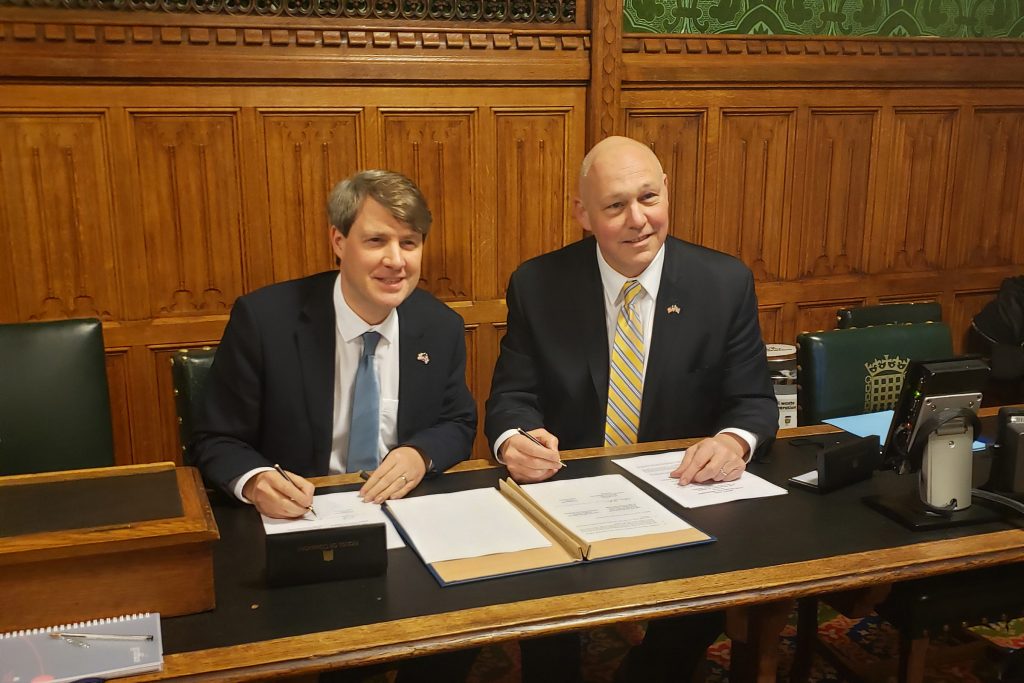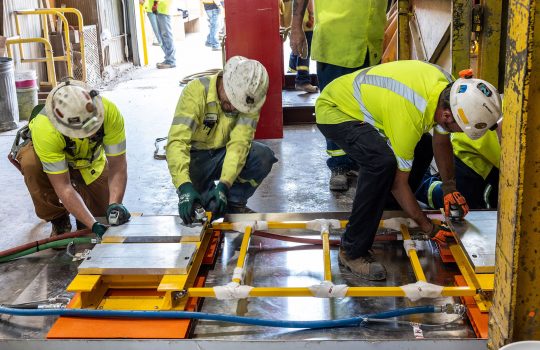Representatives from UK Research and Innovation and the U.S. Department of Energy today signed an agreement that outlines £65 million worth of contributions that UK research institutions and scientists will make to the international Deep Underground Neutrino Experiment and related projects hosted by DOE’s Fermi National Accelerator Laboratory. DUNE will study the properties of mysterious particles called neutrinos, which could help explain more about how the universe works and why matter exists at all.
UK scientists have held leadership positions in DUNE since the inception of the collaboration in 2015. The agreement gives the green light to build major components in the UK for this megascience project. That includes setting up the required lab space and infrastructure at UK research institutions as well as hiring and training personnel.
The UK investments in these international science projects and participation in the design and construction of cutting-edge scientific equipment for these projects will empower UK scientists and institutions to maintain a world leader position in research for years to come.

On Jan. 22 in London, U.S. Department of Energy Office of Science Director Chris Fall, right, and Minister for Universities, Science, Research, and Innovation at the UK Department for Business, Energy and Industrial Strategy Chris Skidmore signed an agreement between DOE and UK Research and Innovation for work on the international LBNF/DUNE project, hosted by Fermilab, and Fermilab’s PIP-II and Short-Baseline Neutrino Program. Photo: DOE Office of Science
“The UK’s continued collaboration with the U.S. on science and innovation reinforces the importance the scientific communities of both countries place on working together to try to answer some of the biggest questions in physics, questions that have the potential to lead to profound changes in our understanding of the universe,” said Professor Mark Thomson, particle physicist and executive chair of UK’s Science and Technology Facilities Council.
“This investment by STFC secures future access for UK scientists to the international DUNE experiment as well as giving UK scientists and engineers the chance to take leading roles in the management and development of the DUNE far detector and also the LBNF neutrino beam and the associated PIP-II accelerator,” Thomson said.
DUNE is the first large-scale U.S.-hosted experiment run as a truly international project, with more than 1,000 scientists and engineers from over 30 countries contributing to the design, construction and operation of the facilities and scientific equipment. The UK research community is a major contributor to the DUNE collaboration, with 14 UK universities and two STFC laboratories providing essential expertise and components to the experiment and facility.
“Our collaboration with the UK remains a cornerstone of DOE’s international partnerships in high energy physics,” said Chris Fall, director of the U.S. Department of Energy Office of Science. “Those partnerships are key to building world-class projects like PIP-II and LBNF/DUNE, hosted by Fermilab, and we are pleased to see our long history of scientific kinship with the UK in this field continue.”
The agreement is a new chapter in the long history of UK research collaboration with the United States. UK contributions will include:
- Design and construction of superconducting particle accelerator components for Fermilab’s Proton Improvement Plan-II accelerator project, which will provide the particles that make the DUNE experiment possible. These accelerator components also have applications in other science projects and have promising potential for use in medical, industrial and environmental applications.
- Design and production of the high-power target for the Long-Baseline Neutrino Facility that scientists will use to produce the neutrinos for DUNE. The work, carried out at the Rutherford Appleton Laboratory in the UK, will also advance research efforts in materials science and nuclear physics.
- Design and assembly of 150 very large particle detector components known as anode plane assemblies that each comprise thousands of delicate sensor wires. The APAs enable scientists to record high-resolution 3-D images of subatomic particle tracks produced in neutrino interactions.
- Development of the data acquisition systems and reconstruction software. Each DUNE module will produce one terabyte of data per second, equivalent to about 1,000 one-hour-long HD movies. Reading out this vast amount of data, and then finding and reconstructing the neutrino interactions, is one of the big challenges.
- Building and shipping major components of the Short-Baseline Near Detector, one of three detectors that make up Fermilab’s Short-Baseline Neutrino program.
DUNE will send neutrinos 1,300 kilometers from Fermilab in Illinois to huge particle detectors 1.5 kilometers underground at the Sanford Underground Research Facility in South Dakota in order to study neutrino oscillations. Scientists will look for the differences in behavior between neutrinos and their antimatter counterparts, antineutrinos, which could provide clues as to why we live in a matter-dominated universe.
DUNE scientists will also watch for neutrinos stemming from a supernova, or star explosion, which could reveal the formation of neutron stars and black holes. Another goal of DUNE is to look for signals from proton decay. Scientists will investigate whether protons live forever or eventually decay, bringing us closer to fully understanding the fundamental forces of nature.
DUNE will help to recruit and train the next generation of particle physicists, giving students at universities around the world the opportunity to publish scientific papers and get hands-on training on one of the world’s most advanced physics projects.
More information about the facility and experiment can be found at fnal.gov/dune.
Fermilab is America’s premier national laboratory for particle physics and accelerator research, funded by the U.S. Department of Energy Office of Science.
UK involvement in LBNF/DUNE/PIP-II/SBN is through UK Research and Innovation and the following universities: Birmingham, Bristol, Cambridge, Durham, Edinburgh, Imperial, Lancaster, Liverpool, University College London, Manchester, Oxford, Sheffield, Sussex and Warwick.



